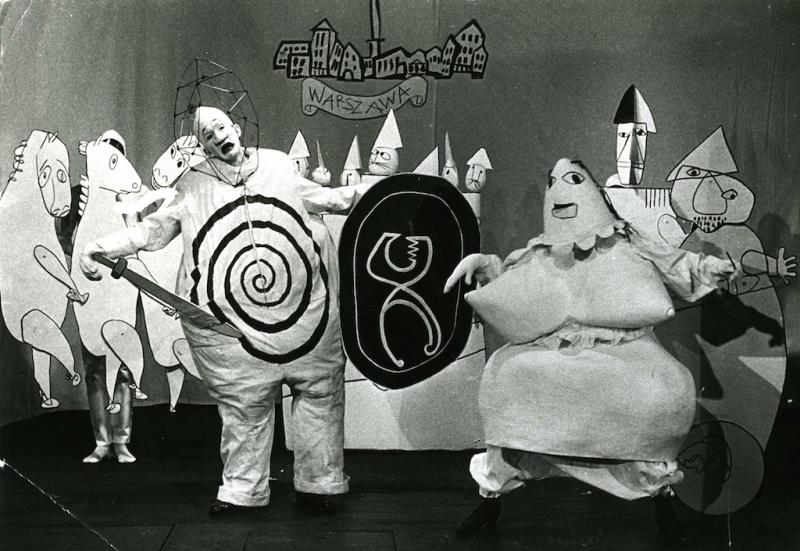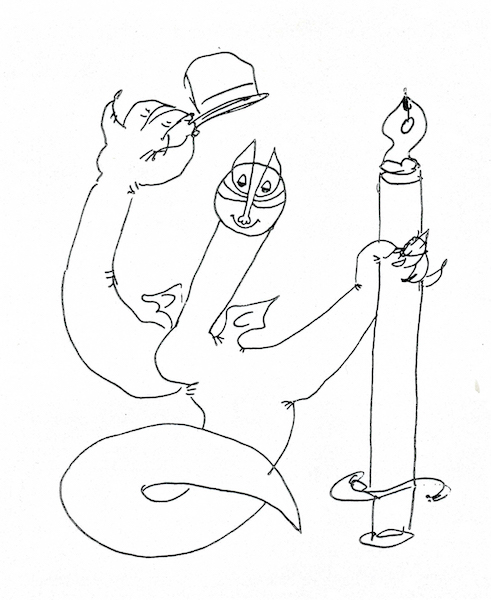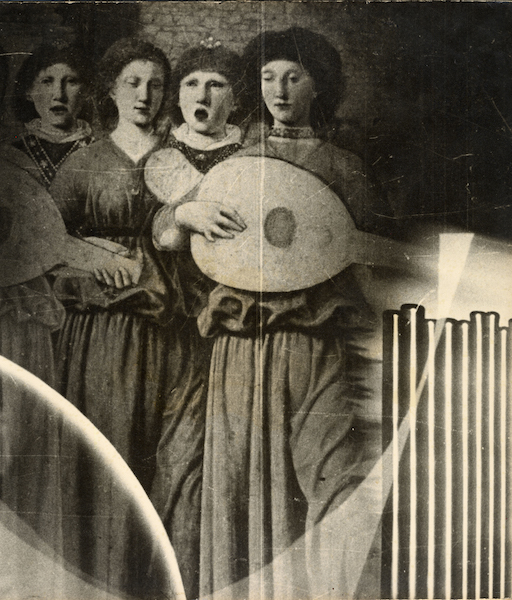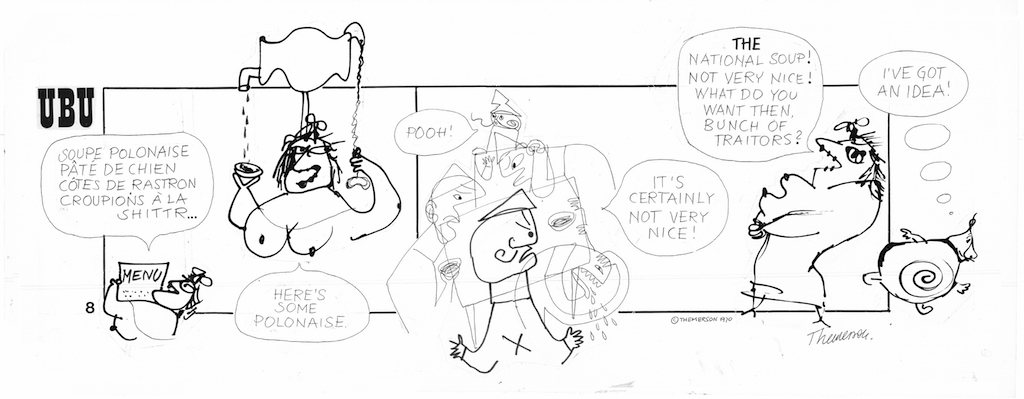Franciszka & Stefan Themerson, Camden Arts Centre | reviews, news & interviews
Franciszka & Stefan Themerson, Camden Arts Centre
Franciszka & Stefan Themerson, Camden Arts Centre
The Polish couple whose brilliant books have had a lasting influence on British design

Bertrand Russell’s History of the World is a charming little booklet that carries a chilling message: “Since Adam and Eve ate the apple, man has never refrained from any folly of which he is capable.” A line drawing shows Adam and Eve sharing a neatly sliced apple followed by a comic depiction of medieval warfare. Next comes “The End” printed opposite a photo of a mushroom cloud.
The booklet was published by the Gaberbocchus Press (colophon pictured below right), whose goal was to produce books that were “best lookers” rather than “best sellers”, in which the visuals are as important as the text. The lines of Apollinaire’s poem Il Pleut (It Rains), for instance, trickle down the page like incessant drizzle. The letters of Stefan Themerson’s poem Enjoy your bath... jump about like bubbles “bobbing up and down on the surface”, even though the poem warns that appearances can be deceptive: “all the waters of the world will harden/ into sharp cold crystals of hate sparkling with millions of enchanting rainbows”.
 Set up in 1948 by Franciszka and Stefan Themerson, the press was named after a spoof Latin translation of Lewis Carroll’s Jabberwocky; the opening phrase “T’was brillig” becomes “Hora aderat briligi”! Carroll’s darkly nonsensical humour appealed to the Themersons, who left Poland just before World War Two and came to London, via Paris.
Set up in 1948 by Franciszka and Stefan Themerson, the press was named after a spoof Latin translation of Lewis Carroll’s Jabberwocky; the opening phrase “T’was brillig” becomes “Hora aderat briligi”! Carroll’s darkly nonsensical humour appealed to the Themersons, who left Poland just before World War Two and came to London, via Paris.
The couple made a great team. Franciszka, who was also a painter, designed and illustrated these enchanting books, while Stefan wrote the poems, novels, essays and children’s stories which they published alongside the work of avant-garde authors like Guillaume Apollinaire and Kurt Schwitters. But their efforts weren’t much appreciated here in Britain. In 1962 the librarian of the Belsize Branch Library refused an offer of three books, including Stefan’s monograph on the German dadaist Schwitters, on the grounds that they would add little to the collection.
 Such indifference must have been especially disappointing since, in Warsaw, they’d been key members of the avant-garde, setting up the Polish Film-makers’ Co-op and making surrealist films inspired by French counterparts, such as René Clair’s Entr’acte, 1924. On show is The Adventure of a Good Citizen, 1937, in which people discover the freedom of walking backwards. Two men carry a wardrobe through the streets and into the woods; cue euphoric shots of light filtering through trees and Tommy Cooper-style gags based on reflections in the wardrobe mirror. The men are followed by a protest march whose members climb through the wardrobe and emerge into a utopian realm, where the furniture-movers fly like birds and play the flute like angels.
Such indifference must have been especially disappointing since, in Warsaw, they’d been key members of the avant-garde, setting up the Polish Film-makers’ Co-op and making surrealist films inspired by French counterparts, such as René Clair’s Entr’acte, 1924. On show is The Adventure of a Good Citizen, 1937, in which people discover the freedom of walking backwards. Two men carry a wardrobe through the streets and into the woods; cue euphoric shots of light filtering through trees and Tommy Cooper-style gags based on reflections in the wardrobe mirror. The men are followed by a protest march whose members climb through the wardrobe and emerge into a utopian realm, where the furniture-movers fly like birds and play the flute like angels.
In England, the Themersons continued to make films such as The Eye and the Ear, 1945, an exploration of the relationship between sound and vision. The angels in Piero della Francesca’s Nativity appear to sing (pictured above left), while in response to the music, abstract shapes representing the human voice and various instruments fill the screen with overlapping patterns reminiscent of art deco designs and the “thought forms” with which Rudolf Steiner illustrated similar concepts. The British censors banned Calling Mr Smith, 1943, in which sampled newsreel footage, photograms and stop-motion animation are used to create a harrowing account of the Nazi destruction of Polish culture.
 But it's the books that are the most memorable. They provided one of those eureka moments, when work you think you don’t know turns out to be extremely familiar. The case in point is Alfred Jarry’s absurdist play Ubu Roi, 1896. The Themersons published the first English translation of this comic classic, and Franciszka also produced the masks for a reading of the play at the Institute of Contemporary Art in 1952 and the costumes and sets for a 1964 production in Stockholm’s marionette theatre, which then toured the world. In 1969 she began a comic strip version in which the delicacy of her line makes the antics of the demonic anti-hero seem even more preposterous and arbitrary (pictured above).
But it's the books that are the most memorable. They provided one of those eureka moments, when work you think you don’t know turns out to be extremely familiar. The case in point is Alfred Jarry’s absurdist play Ubu Roi, 1896. The Themersons published the first English translation of this comic classic, and Franciszka also produced the masks for a reading of the play at the Institute of Contemporary Art in 1952 and the costumes and sets for a 1964 production in Stockholm’s marionette theatre, which then toured the world. In 1969 she began a comic strip version in which the delicacy of her line makes the antics of the demonic anti-hero seem even more preposterous and arbitrary (pictured above).
Having gone to Camden thinking I’d never heard of the Themersons, I came away realising that their beguiling imagery had long since infiltrated my very being, as well as having a huge influence on British design and illustration.
rating
Share this article
more Visual arts
 Fantastic Machine review - photography's story from one camera to 45 billion
Love it or hate it, the photographic image has ensnared us all
Fantastic Machine review - photography's story from one camera to 45 billion
Love it or hate it, the photographic image has ensnared us all
 Yinka Shonibare: Suspended States, Serpentine Gallery review - pure delight
Weighty subject matter treated with the lightest of touch
Yinka Shonibare: Suspended States, Serpentine Gallery review - pure delight
Weighty subject matter treated with the lightest of touch
 Jane Harris: Ellipse, Frac Nouvelle-Aquitaine MÉCA, Bordeaux review - ovals to the fore
Persistence and conviction in the works of the late English painter
Jane Harris: Ellipse, Frac Nouvelle-Aquitaine MÉCA, Bordeaux review - ovals to the fore
Persistence and conviction in the works of the late English painter
 Sargent and Fashion, Tate Britain review - portraiture as a performance
London’s elite posing dressed up to the nines
Sargent and Fashion, Tate Britain review - portraiture as a performance
London’s elite posing dressed up to the nines
 Zineb Sedira: Dreams Have No Titles, Whitechapel Gallery review - a disorientating mix of fact and fiction
An exhibition that begs the question 'What and where is home?'
Zineb Sedira: Dreams Have No Titles, Whitechapel Gallery review - a disorientating mix of fact and fiction
An exhibition that begs the question 'What and where is home?'
 Yoko Ono: Music of the Mind, Tate Modern review - a fitting celebration of the early years
Acknowledgement as a major avant garde artist comes at 90
Yoko Ono: Music of the Mind, Tate Modern review - a fitting celebration of the early years
Acknowledgement as a major avant garde artist comes at 90
 Unravel: The Power and Politics of Textiles in Art, Barbican review - the fabric of dissent
An ambitious exploration of a neglected medium
Unravel: The Power and Politics of Textiles in Art, Barbican review - the fabric of dissent
An ambitious exploration of a neglected medium
 When Forms Come Alive, Hayward Gallery review - how to reduce good art to family fun
Seriously good sculptures presented as little more than playthings or jokes
When Forms Come Alive, Hayward Gallery review - how to reduce good art to family fun
Seriously good sculptures presented as little more than playthings or jokes
 Entangled Pasts 1768-now, Royal Academy review - an institution exploring its racist past
After a long, slow journey from invisibility to agency, black people finally get a look in
Entangled Pasts 1768-now, Royal Academy review - an institution exploring its racist past
After a long, slow journey from invisibility to agency, black people finally get a look in
 Barbara Kruger, Serpentine Gallery review - clever, funny and chilling installations
Exploring the lies, deceptions and hyperbole used to cajole, bully and manipulate us
Barbara Kruger, Serpentine Gallery review - clever, funny and chilling installations
Exploring the lies, deceptions and hyperbole used to cajole, bully and manipulate us
 Richard Dorment: Warhol After Warhol review - beyond criticism
A venerable art critic reflects on the darkest hearts of our aesthetic market
Richard Dorment: Warhol After Warhol review - beyond criticism
A venerable art critic reflects on the darkest hearts of our aesthetic market
 Dineo Seshee Raisibe Bopape: (ka) pheko ye / the dream to come, Kiasma, Helsinki review - psychic archaeology
The South African artist evokes the Finnish landscape in a multisensory installation
Dineo Seshee Raisibe Bopape: (ka) pheko ye / the dream to come, Kiasma, Helsinki review - psychic archaeology
The South African artist evokes the Finnish landscape in a multisensory installation

Add comment